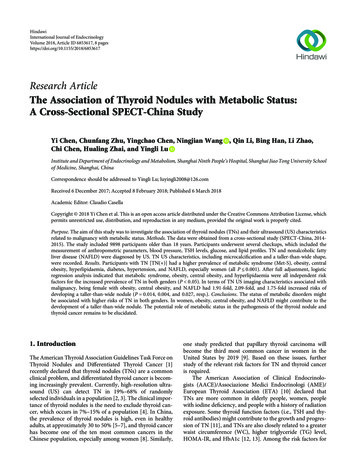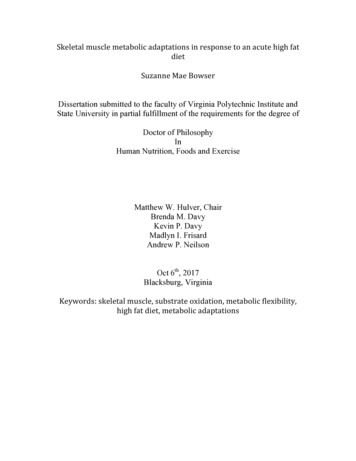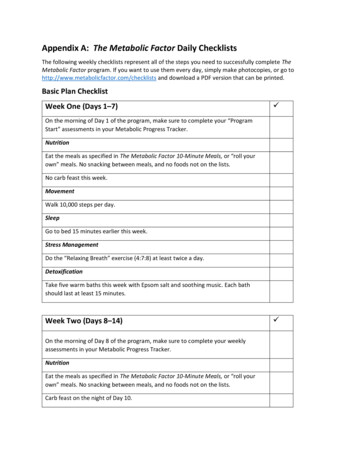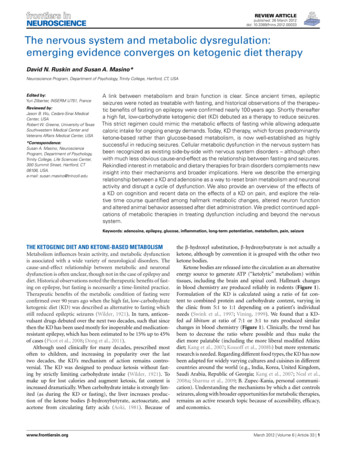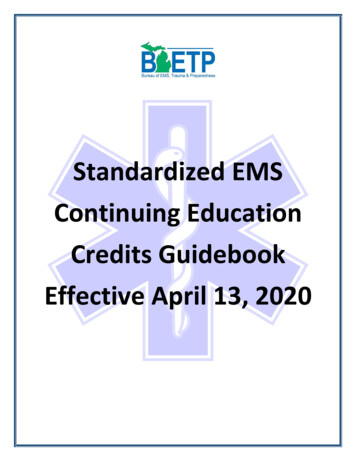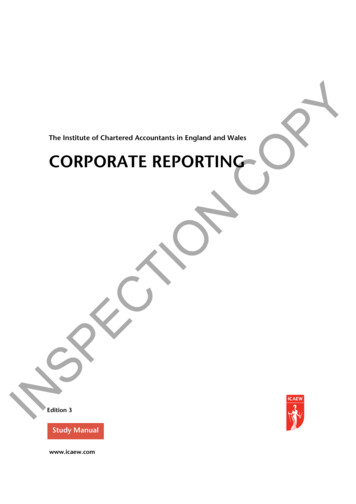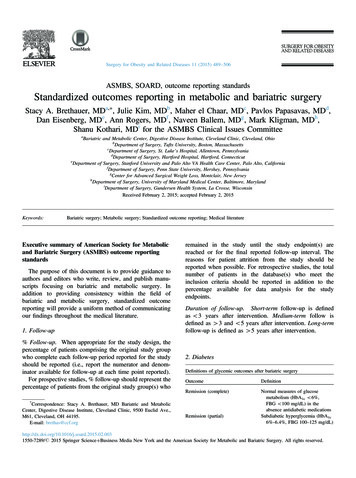
Transcription
Surgery for Obesity and Related Diseases 11 (2015) 489–506ASMBS, SOARD, outcome reporting standardsStandardized outcomes reporting in metabolic and bariatric surgeryStacy A. Brethauer, MDa,*, Julie Kim, MDb, Maher el Chaar, MDc, Pavlos Papasavas, MDd,Dan Eisenberg, MDe, Ann Rogers, MDf, Naveen Ballem, MDg, Mark Kligman, MDh,Shanu Kothari, MDi for the ASMBS Clinical Issues CommitteeaBariatric and Metabolic Center, Digestive Disease Institute, Cleveland Clinic, Cleveland, OhiobDepartment of Surgery, Tufts University, Boston, MassachusettscDepartment of Surgery, St. Luke’s Hospital, Allentown, PennsylvaniadDepartment of Surgery, Hartford Hospital, Hartford, ConnecticuteDepartment of Surgery, Stanford University and Palo Alto VA Health Care Center, Palo Alto, CaliforniafDepartment of Surgery, Penn State University, Hershey, PennsylvaniagCenter for Advanced Surgical Weight Loss, Montclair, New JerseyhDepartment of Surgery, University of Maryland Medical Center, Baltimore, MarylandiDepartment of Surgery, Gundersen Health System, La Crosse, WisconsinReceived February 2, 2015; accepted February 2, 2015Keywords:Bariatric surgery; Metabolic surgery; Standardized outcome reporting; Medical literatureExecutive summary of American Society for Metabolicand Bariatric Surgery (ASMBS) outcome reportingstandardsThe purpose of this document is to provide guidance toauthors and editors who write, review, and publish manuscripts focusing on bariatric and metabolic surgery. Inaddition to providing consistency within the field ofbariatric and metabolic surgery, standardized outcomereporting will provide a uniform method of communicatingour findings throughout the medical literature.1. Follow-up% Follow-up. When appropriate for the study design, thepercentage of patients comprising the original study groupwho complete each follow-up period reported for the studyshould be reported (i.e., report the numerator and denominator available for follow-up at each time point reported).For prospective studies, % follow-up should represent thepercentage of patients from the original study group(s) who*Correspondence: Stacy A. Brethauer, MD Bariatric and MetabolicCenter, Digestive Disease Institute, Cleveland Clinic, 9500 Euclid Ave.,M61, Cleveland, OH 44195.E-mail: brethas@ccf.orgremained in the study until the study endpoint(s) arereached or for the final reported follow-up interval. Thereasons for patient attrition from the study should bereported when possible. For retrospective studies, the totalnumber of patients in the database(s) who meet theinclusion criteria should be reported in addition to thepercentage available for data analysis for the studyendpoints.Duration of follow-up. Short-term follow-up is definedas o3 years after intervention. Medium-term follow isdefined as 43 and o5 years after intervention. Long-termfollow-up is defined as 45 years after intervention.2. DiabetesDefinitions of glycemic outcomes after bariatric surgeryOutcomeDefinitionRemission (complete)Normal measures of glucosemetabolism (HbA1c o6%,FBG o100 mg/dL) in theabsence antidiabetic medicationsSubdiabetic hyperglycemia (HbA1c6%–6.4%, FBG 100–125 mg/dL)Remission .0031550-7289/r 2015 Springer ScienceþBusiness Media New York and the American Society for Metabolic and Bariatric Surgery. All rights reserved.
490S. A. Brethauer et al. / Surgery for Obesity and Related Diseases 11 (2015) 489–506in the absence antidiabeticmedicationsStatistically significant reduction inHbA1c and FBG not meetingcriteria for remission or decreasein antidiabetic medicationsrequirement (by discontinuinginsulin or one oral agent, or ½reduction in dose)The absence of remission orimprovement as described earlierFBG or HbA1c in the diabetic range(Z126 mg/dL and Z6.5%,respectively) or need forantidiabetic medication after anyperiod of complete or c ¼ glycosylated hemoglobin; FBG ¼ fasting blood glucose.3. HypertensionStage of hypertension before and after bariatric surgery atthe defined follow-up intervals are as follows:Prehypertension (120–140/80–89 systolic/diastolic)Stage 1 hypertension (140–159/90–99)Stage 2 hypertension (4160/4100)Antihypertensive medication use should be reported(clearly define indication for medication as treatment ofhypertension). Reporting medication type or class and duration of therapy is also recommended with the understandingthat this may not be feasible in retrospective sion:Defined as a decrease in dosage or number ofantihypertensive medication or decrease in systolic ordiastolic blood pressure (BP) on the same medication(better control).Defined as prehypertension values (120–140/80–89)when off medication.Defined as being normotensive (BP o120/80) offantihypertensive medication.If medication such as beta-blockade is used for anotherindication (atrial fibrillation), this needs to be clearlydescribed but cannot be included as complete remissionbecause of the dual therapeutic effect of some medications.4. DyslipidemiaIt is recommended that reporting practice for dyslipidemia after bariatric surgery follow the Adult Treatment PanelIII Guidelines, 2001, of the National Heart, Lung and BloodInstitute. These values reflect fasting blood samples:LDLo100 mg/dL ¼ optimal (or o40 mg/dL if another riskcholesterolfactor is present)100–129 mg/dL ¼ near optimal130–159 mg/dL ¼ borderline highHDLcholesterol160–189 mg/dL ¼ high4190 mg/dL ¼ very higho40 mg/dL ¼ low460 mg/dL ¼ highTotalo200 mg/dL ¼ desirablecholesterol200–239 mg/dL ¼ borderline high4240 mg/dL ¼ highTriglycerides o150 mg/dL ¼ normal150–199 mg/dL ¼ borderline high200–499 mg/dL ¼ high4500 mg/dL ¼ very highLDL ¼ low-density lipoprotein; HDL ¼ high-density lipoprotein.Cardiovascular risk may then be calculated as the totalcholesterol/HDL ratio:½ average risk ¼ 3.27average risk ¼ 4.442 average risk ¼ 7.053 average risk ¼ 11.04Indication for cholesterol and lipid-lowering medicationuse should be clearly stated.Improvement: Decrease in number or dose of lipid-lowering agents withequivalent control of dyslipidemia or improved controlof lipids on equivalent medication.Authors must specify which components of the lipid profileare being studied and report them as individual outcomeswhen possible.Cardiovascular risk based on total cholesterol (TC)/HDL orother risk scoring systems can be used to provide a moreglobal assessment of lipid changes after surgery.Remission:Normal lipid panel (or specific component being studied)off medication.5. Obstructive sleep apnea (OSA)Recognizing that not all patients will undergo repeattesting, a “subjective” category is included here in additionto the “objective” findings. Reporting complete remissionor objective improvement is preferred over tObjective:In those patients with preoperative polysomnography(PSG) with diagnosis of OSA, complete remissionwould be defined as AHI/RDI of o5 off CPAP/BIPAP on repeat objective testing with PSG.Requires some form of measurable improvement:Reduced pressure settings on CPAP/BI-PAP asrecommended by a sleep medicine provider.Decreased severity of disease on repeat objective testingwith PSG (e.g., going from severe to mild).Improved repeat score on screening tool compared withpreoperative.
Standardized Outcomes Reporting / Surgery for Obesity and Related Diseases 11 (2015) 489–506Subjective:Patients with preoperative documentation of OSA whohave not or will not undergo repeat objective testingwith PSG.Document personal or witnessed improvement in sleephygiene and symptoms of sleep apnea.Have self-discontinued the use of sleep apnea treatmentCPAP/BiPAP based on improved symptoms.CPAP ¼ continuous positive airway pressure; Bi-PAP ¼ bilevel positiveairway pressure.6. Gastroesophageal reflux disease (GERD)In the evaluation and reporting of GERD after bariatricsurgery, the following recommendations are made:1. Use of a validated questionnaire pre- and postsurgery2. Recording and reporting medication use and specificindication3. Minimum of 1-year follow-up and, ideally, long-termfollow-up that is procedure-specificLike OSA, there may be subjective self-reported criteriato define improvement of GERD after surgery as well asobjective criteria. Objective, procedure-specific criteria arepreferred. Authors should specify whether their outcomesare based on objective or subjective criteria.Complete resolution(objective):Complete ovement (selfreported):Absence of symptoms (normal symptom score)andNo medication use andNormal physiologic test (24- or 48-hr pH study,impedance study [preferred], and/orendoscopy])Absence of symptoms andNo medication useImproved symptom score on validated testing orDecreased or as needed medication use* orImproved physiologic test (24- or 48-hour pHstudy, impedance study, and/or endoscopy)Improved symptom severity or frequency orDecreased or as needed medication use**Decreased or as-needed medication associated with improvement ofsymptoms and not ineffectiveness of medication, cost, or other reasons.7. Complications491Examples of major complications Examples of major complications include the following: Venous thrombotic event (VTE) requiring administrationof anticoagulant or intervention, such as embolectomy,inferior vena caval (IVC) filter Anastomotic leak requiring reoperation, percutaneous drainage of abscess, stent placement or conservative managementwith parenteral nutrition and nothing per os (NPO) Gastrointestinal hemorrhage requiring transfusion orintervention Small bowel obstruction requiring reoperation Bowel perforation requiring reoperation Trocar site hernia requiring reoperation Death Myocardial infarction Cerebrovascular accident Renal failure requiring dialysis Respiratory failure requiring intervention such asintubation Prolonged hospitalization (47 d) Chronic nausea and vomiting not responsive to conservative management and requiring total parenteralnutrition (TPN) Gastric sleeve stenosis/obstruction requiring revision to agastric bypass Surgical site infection (superficial, deep, or organ space)requiring debridement or washout in the operating roomor percutaneous intervention Small bowel stenosis, stricture, or obstruction requiringrevision of the jejunojejunostomyExamples of minor complications. Examples of minorcomplications include the following: Marginal ulcer diagnosed with upper endoscopy Anastomotic stricture requiring endoscopic dilation Nausea and vomiting requiring intravenous fluids (IVF)but not TPN Acute renal failure managed with IVF without the needof dialysis Gastrointestinal ileus managed conservatively Incisional hernia (diagnosed during routine follow-up) Trocar site surgical site infection managed with drainageand local wound care Negative re-exploration (e.g., diagnostic laparoscopy toComplicationMajorMinorEarly o30 daysLate 430 daysEarly majorLate majorEarly minorLate minor Urinary tract infection managed with antibiotics Dehydration requiring IV hydration as an inpatient Vitamin or mineral deficiency requiring IV supplemen-Major complications include any complication that resultin a prolonged hospital stay (beyond 7 days), administrationof an anticoagulant, reintervention, or reoperation.Minor complications include everything else that is notincluded under major.tation (e.g., severe anemia requiring IV iron infusion orsevere vitamin B12 requiring vitamin B12 injections orsymptomatic thiamine deficiency requiring IV thiamine) Nephrolithiasis Symptomatic cholelithiasisrule out leak or for unexplained tachycardia)
492S. A. Brethauer et al. / Surgery for Obesity and Related Diseases 11 (2015) 489–5068. Weight LossReporting of weight loss outcomes after bariatric surgeryshould include the following parameters (in which initialweight is the patient's weight as measured closest to thetime of surgery and initial BMI is the body mass index(BMI) determined closest to the time of surgery in thepreoperative period):Complete reporting is recommended as follows:1. Mean initial BMI of the cohort2. Change in BMI (ΔBMI):ΔBMI ¼ (Initial BMI) – (Postop BMI)3. Percent of total weight loss (%TWL):%TWL ¼ [(Initial Weight) – (Postop Weight)] / [(InitialWeight)] 1004. Percent excess BMI loss (%EBMIL):%EBMIL ¼ [ΔBMI / (Initial BMI – 25)] 100and/orPercent excess weight loss (%EWL)%EWL ¼ [(Initial Weight) – (Postop Weight)] / [(InitialWeight) – (Ideal Weight)](in which ideal weight is defined by the weight corresponding to a BMI of 25 kg/m2; see Appendix A)9. Quality of lifeCurrently, psychological testing in bariatric surgeryhas been used primarily as a descriptive measure or todetermine treatment effects in well-defined populations.Consequently, in the context of evaluating programoutcomes, no specific recommendations are supportedby the current literature. In the context of reportingtreatment effects, the need for a generic instrument, asystem- and condition-specific instrument, an obesityspecific instrument, or a combination of tools should bemade based on the specific research aims. However, werecommend the use of a validated instrument is for allpublished reports.Standardized outcomes reporting in metabolic andbariatric surgeryTo date, there has been no standardized or systematicmethod of reporting outcomes in the bariatric surgeryliterature. As a result, weight loss is commonly reporteddifferently throughout the medical and surgical literature.Additionally, the definitions of co-morbidity improvementand remission have been inconsistent and this has madeinterpretation of these results across studies difficult.Several systematic reviews of the bariatric and metabolicsurgery literature have been conducted. The conclusionsobtained from these reviews have been weakened by thequality of the data included and the variability of endpointsfor weight and co-morbidities throughout the studiesreviewed.The purpose of this document is to provide guidance toauthors and editors who write, review, and publish manuscripts focusing on bariatric and metabolic surgery. Inaddition to providing consistency within the field ofbariatric and metabolic surgery, standardized outcomereporting will provide a uniform method of communicatingour findings throughout the medical literature.1. Follow-upObesity is a chronic disease and its treatment requiresclose follow-up to accurately assess the efficacy anddurability of any treatment strategy. It is widely acceptedthat bariatric surgery patients require lifetime follow-up toassess for weight loss, co-morbidity changes, and nutritionaldeficiencies. The type and frequency of follow-up dependson the specific operation, but a standardized approach topostoperative follow-up schedules has been required forprograms to participate in accreditation and qualityimprovement programs.Current practices. Current methods of reporting follow-upin the bariatric literature vary widely, and this presentssignificant challenges in interpreting the results of manypublished studies. To date, there has not been a uniformmethod or even a requirement to report follow-up rates forcohorts of patients. Follow-up rates are most often reportedfor prospective studies. Retrospective studies, however,most often do not report the percentage of patients includedin a study as a percentage of patients in the database whowere eligible for inclusion. The duration of follow-up(short, medium, and long term) is not presented in auniform manner across the bariatric literature.Challenges. The primary challenge is in achieving consistency in follow-up reporting across various types ofbariatric publications in various journals. The requirementand necessity for reporting follow-up rates for prospectivestudies is clear. Enforcing the requirement to include thetotal patient number (denominator) for retrospective studiespresents a greater challenge but is worth pursuing to addressthe large amount of selection bias in the current bariatricliterature.Recommended reporting. % Follow-up. When appropriatefor the study design, the percentage of patients comprisingthe original study group who complete each follow-upperiod reported for the study should be reported (i.e., reportthe numerator and denominator available for follow-up ateach time point reported). For prospective studies, percentfollow-up should represent the percentage of patients fromthe original study group(s) who remained in the study untilthe study endpoints are reached or for the final reportedfollow-up interval. The reasons for patient attrition from the
Standardized Outcomes Reporting / Surgery for Obesity and Related Diseases 11 (2015) 489–506study should be reported when possible. For retrospectivestudies, the total number of patients in the database whomeet the inclusion criteria should be reported in addition tothe percentage available for data analysis for the studyendpoints.Duration of follow-up. Short-term follow-up is definedas o3 years after intervention. Medium-term follow-up isdefined as 43 and o5 years after intervention. Long-termfollow-up is defined as 45 years after intervention.2. DiabetesThe field of metabolic and bariatric surgery has advancedrapidly over the last decade and this is due in large part tothe effect of these operations on type 2 diabetes mellitus(T2DM). There is a large body of literature demonstratingthe early and mid-term effects of bariatric procedures ondiabetes remission and improvement and several that havereported the durability of these effects beyond 5 years. Overtime, definitions of diabetes remission based on biochemicalparameters have changed and there is a wide variety ofdefinitions for remission used throughout the bariatricliterature. As this field continues to progress, clear biochemical endpoints and definitions of diabetes improvement, remission, and recurrence must be established andreported consistently in the bariatric literature.Current practicesThere is no consistency in how diabetes remission hasbeen reported in the bariatric literature. Definitions haveranged from patient-reported medication discontinuation tostrict biochemical parameters. The American DiabetesAssociation (ADA) publishes clear criteria to define thedisease of T2DM and prediabetes [1]. The current ADAtarget of therapy is an HbA1c o7%, but this target oftherapy implies only adequate control with or withoutmedication. Normoglycemia based on HbA1c and fastingblood glucose off medication has been used more commonly in recent publications, but even some recent publications in high-impact journals have used subdiabetichyperglycemia in their definition of remission.Challenges. Even though obtaining fasting glucose levelsand HbA1c levels are routine and considered standard ofcare for diabetic patients, it can be difficult to obtain theseparameters from retrospective studies. Prospective trials thatare evaluating diabetic outcomes as a primary or secondaryendpoint, however, should include these biochemicalparameters as well as medication usage in their studydesign if appropriate. One major challenge potentiallyencountered in longer-term studies, particularly retrospective studies, is that patients who achieve complete remissionof their diabetes are no longer considered diabetic by theirprimary physician or insurance company and either don’thave these laboratory measurements drawn annually or493don’t have insurance coverage for them any longer. Inprospective trials, these laboratory measurements should beincluded in the budgeting for long-term follow-up becausethey may no longer be considered “standard of care” forsome patients in remission.The other major challenge is to communicate consistentlyin the literature and present accurate biochemical parameters that are agreeable to our medical colleagues. Moremechanistic evaluations such as euglycemic hyperinsulinemic clamp studies are extremely helpful in communicatingour findings to endocrinologists, though this type of study isnot always practical or feasible.Recommended reporting.Definitions of glycemic outcomes after bariatric l measures of glucose metabolism (HbA1c o6%,FBG o100 mg/dL) in the absence of antidiabeticmedicationsSubdiabetic hyperglycemia (HbA1c 6%–6.4%, FBG100–125 mg/dL) in the absence of antidiabeticmedicationsStatistically significant reduction in HbA1c and FBG notmeeting criteria for remission or decrease inantidiabetic medications requirement (bydiscontinuing insulin or 1 oral agent, or ½ reduction indose)The absence of remission or improvement as describedearlierFBG or HbA1c in the diabetic range (Z126 mg/dLand Z6.5%, respectively) or need for antidiabeticmedication after any period of complete or ngedRecurrenceHbA1c ¼ glycosylated hemoglobin; FBG ¼ fasting blood glucose.Adapted from Buse JB, Caprio S, Cefalu WT, et al. Howdo we define cure of diabetes? Diabetes Care 2009;32(11):2133–5; and Schauer PR, Burguera B, Ikramuddin S,et al. Effect of laparoscopic Roux-en-Y gastric bypass ontype 2 diabetes mellitus. Ann Surg 2003;238(4):467–84.References[1] Pories WJ, Swanson MS, MacDonald KG, et al. Who would havethought it? An operation proves to be the most effective therapy foradult-onset diabetes mellitus. Ann Surg 1995;222(3):339–50; discussion 350–2.[2] Schauer PR, Burguera B, Ikramuddin S, et al. Effect of laparoscopicRoux-en-Y gastric bypass on type 2 diabetes mellitus. Ann Surg2003;238(4):467–84; discussion 84–5.[3] Dixon JB, O'Brien PE, Playfair J, et al. Adjustable gastric banding andconventional therapy for type 2 diabetes: a randomized controlled trial.JAMA 2008;299(3):316–23.[4] Gill RS, Birch DW, Shi X, et al. Sleeve gastrectomy and type 2diabetes mellitus: a systematic review. Surg Obes Relat Dis; 6(6):707–13.
494S. A. Brethauer et al. / Surgery for Obesity and Related Diseases 11 (2015) 489–506[5] DeMaria EJ, Sugerman HJ, Kellum JM, et al. Results of 281consecutive total laparoscopic Roux-en-Y gastric bypasses to treatmorbid obesity. Ann Surg 2002;235(5):640–5; discussion 645–7.[6] Cohen RV, Pinheiro JC, Schiavon CA, et al. Effects of gastric bypasssurgery in patients with type 2 diabetes and only mild obesity. DiabetesCare 2012;35(7):1420–8.[7] Dixon JB, Zimmet P, Alberti KG, et al. Bariatric surgery for diabetes:the International Diabetes Federation takes a position. J Diabetes2011;3(4):261–4.[8] American Diabetes Association. Standards of medical care in diabetes—2013. Diabetes Care 2013;36(Suppl 1):S11–66.[9] Buchwald H, Estok R, Fahrbach K, et al. Weight and type 2 diabetesafter bariatric surgery: systematic review and meta-analysis. Am JMed 2009;122(3):248–256 e5.[10] Brethauer SA, Aminian A, Romero-Talamas H, et al. Can diabetes besurgically cured? Long-term metabolic effects of bariatric surgery inobese patients with type 2 diabetes. Ann Surg 2013;258(4):628–37.[11] Sjostrom L, Peltonen M, Jacobson P, et al. Bariatric surgery and longterm cardiovascular events. JAMA 2012;307(1):56–65.[12] Buse JB, Caprio S, Cefalu WT, et al. How do we define cure ofdiabetes? Diabetes Care 2009;32(11):2133–5.3. HypertensionReporting of the effects of weight loss and its impact onhypertension is rather confusing because of the wide range ofdefinitions used to quantify hypertension, prehypertension,and hypertensive crisis. Another point of conflict is the use ofhypertension medications for their secondary effects such asfor treatment of atrial fibrillation, migraines, and so on.Lastly, the accepted ranges of normal systolic and diastolicpressure change over the course of life, and changing“normal” values must be considered when reporting the data.Hypertension affects 1 billion individuals worldwide andcarries an increased risk of mortality and morbidity becauseof its association with strokes, coronary heart disease,congestive heart failure, and end-stage renal disease. Hypertension, as defined by the American Heart Association, isdivided into stages. Stage 1 hypertension occurs when thesystolic blood pressure (BP) is between 140 and 159 mmHg or the diastolic range falls between 90 and 99 mm Hg.Stage 2 hypertension occurs when systolic readings areconsistently 4160 mm Hg or diastolic readings are 4100mm Hg. Hypertensive crisis requiring immediate intervention occurs when systolic readings are 4180 mm Hg ordiastolic readings are 4110 mm Hg. Normotensive valuesare reported as a systolic o120 mm Hg and a diastolic o80 mm Hg. Prehypertension occurs when a systolicreading falls between 120 and 139 mm Hg or a diastolicreading falls between 80 and 89 mm Hg.Treatment of hypertension, regardless of the degree or stage,begins with lifestyle management (dietary restriction, behaviormodification, and increased activity). Currently there are 475antihypertensive medications available in the United States in9 classes with continued interest in newer targeted therapies.Although traditional thought was to begin pharmacologictherapy for stage 1 hypertension, the new paradigm suggeststhat pharmacologic treatment begin during the prehypertensivestage because it can reduce the risk of major cardiovascularevents by 18%–42%. The Canadian Hypertension EducationProgram Evidence-Based Recommendations Task Force recommended pharmacotherapy targets of BP o140/90 mm Hgin all patients but o130/80 mm Hg in those with diabetesmellitus or chronic kidney disease. In the United States, 33%of the population has hypertension and is under medicaltreatment. The trend to treat prehypertension with pharmacotherapy is rapidly gaining favor, and the target blood pressureranges are also trending lower. There is a wealth of literaturethat indicates that treating obesity with lifestyle managementalone or in conjunction with bariatric surgery has major effectson improving hypertension and its associated sequelae.Current reporting practices. Various studies have documented the significant impact bariatric surgery has on theimprovement and resolution of hypertension. Currently there isno standard definition of hypertension or stage of hypertensionto be used in the bariatric literature. Additionally, stating that apatient decreased medication use does not provide theimportant details needed to understand the effects of theintervention (surgery) on the disease of hypertension becausemany of these medications have multiple indications.Challenges and controversies. Multiple issues exist whenreporting the impact of surgery on hypertension, includingpatient compliance. Because many hypertensive medications have multiple indications beyond hypertension, it isimportant to ensure that the initial indication for the specifichypertensive was to treat a specific stage of hypertension.There is also a relative lack of data comparing the efficacyof different bariatric procedures on hypertension or discussions regarding mechanisms beyond weight loss. Additionally, reporting of hypertension outcomes in the bariatricliterature may be confounded by differences in age, sex, andusage of nicotine products among a study cohort.Recommended reporting practices. For consistency inreporting and comparing data, defined parameters shouldbe followed. Patient age; gender; the presence of diabetes,chronic kidney disease, or collagen disorders; ethnicity; andsmoking history should carefully be outlined, because eachof these factors may play an important role in hypertensionmanagement. When reporting hypertension outcomes aftermetabolic and bariatric procedures, the following stagingsystem should be used:Stage of hypertension before andafter bariatric surgery at definedfollow-up intervals:Antihypertensive medication use:Prehypertension (120–140/80–89)Stage 1 hypertension (140–159/90–99)Stage 2 hypertension (460/4100)Clearly define indication for medicationas treatment of hypertension.Reporting medication type or classand duration of therapy is alsorecommended, with theunderstanding that this may not befeasible in retrospective studies.
Standardized Outcomes Reporting / Surgery for Obesity and Related Diseases 11 (2015) 489–506Improvement:Partial remission:Complete remission:Decrease in dosage or number ofantihypertensive medication ordecrease in systolic or diastolicblood pressure on samemedication (better control).Prehypertension values (120–140/80–89) off medication.Normotensive (BP o120/80) offantihypertensive medication. Ifmedication such as beta-blockadeis used for another indication(e.g., atrial fibrillation), this needsto be clearly described but cannotbe included as complete remissionbecause of the dual therapeuticeffect of some medications.References[1] Victor RG. Systemic hypertension: mechanisms and diagnosis. In:Bonow RO, Mann DL, Zipes DP, Libby P, editors. Braunwald's heartdisease: a textbook of cardiovascular medicine. 9th ed. Philadelphia:Saunders Elsevier; 2011.[2] Fuchs FD. Prehypertension: the rationale for early drug therapy.Cariovasc Ther 2010; 28(6):339–43.[3] Israili ZH, Hernandez-Hernandez R, Valasco M. The future ofantihypertensive treatment. Department of Medicine, Emory University School of Medicine[4] Khan NA. The 2006 Canadian Hypertension Education Programrecommendations for the management of hypertension: Part II—Therapy. Can J Cardiology 2006;22(7):583–93.4. DyslipidemiaThe words hyperlipidemia and dyslipidemia are usedinterchangeably and refer to an abnormal amount of one ormore lipids in the blood. Dyslipidemia may be seen in50%–80% of obese persons. Although it is commonly seenin conjunction with other weight-related co-morbiditiessuch as diabetes mellitus and hypertension, dyslipidemiais a primary major risk factor for both cardiovasculardisease and cerebrovascular disease, and therefore itsimprovement or resolution has been deemed important tostudy after weight loss surgery.The general recommendation for screening of blood lipidsis a complete fasting lipoprotein profile, including totalcholesterol, LDL cholesterol, HDL cholesterol, and trig
8. Weight Loss Reporting of weight loss outcomes after bariatric surgery should include the following parameters (in which initial weight is the patient's weight as measured closest to the time of surgery and initial BMI is the body mass index (BMI) determined closest to the time of surgery in the preoperative period):
